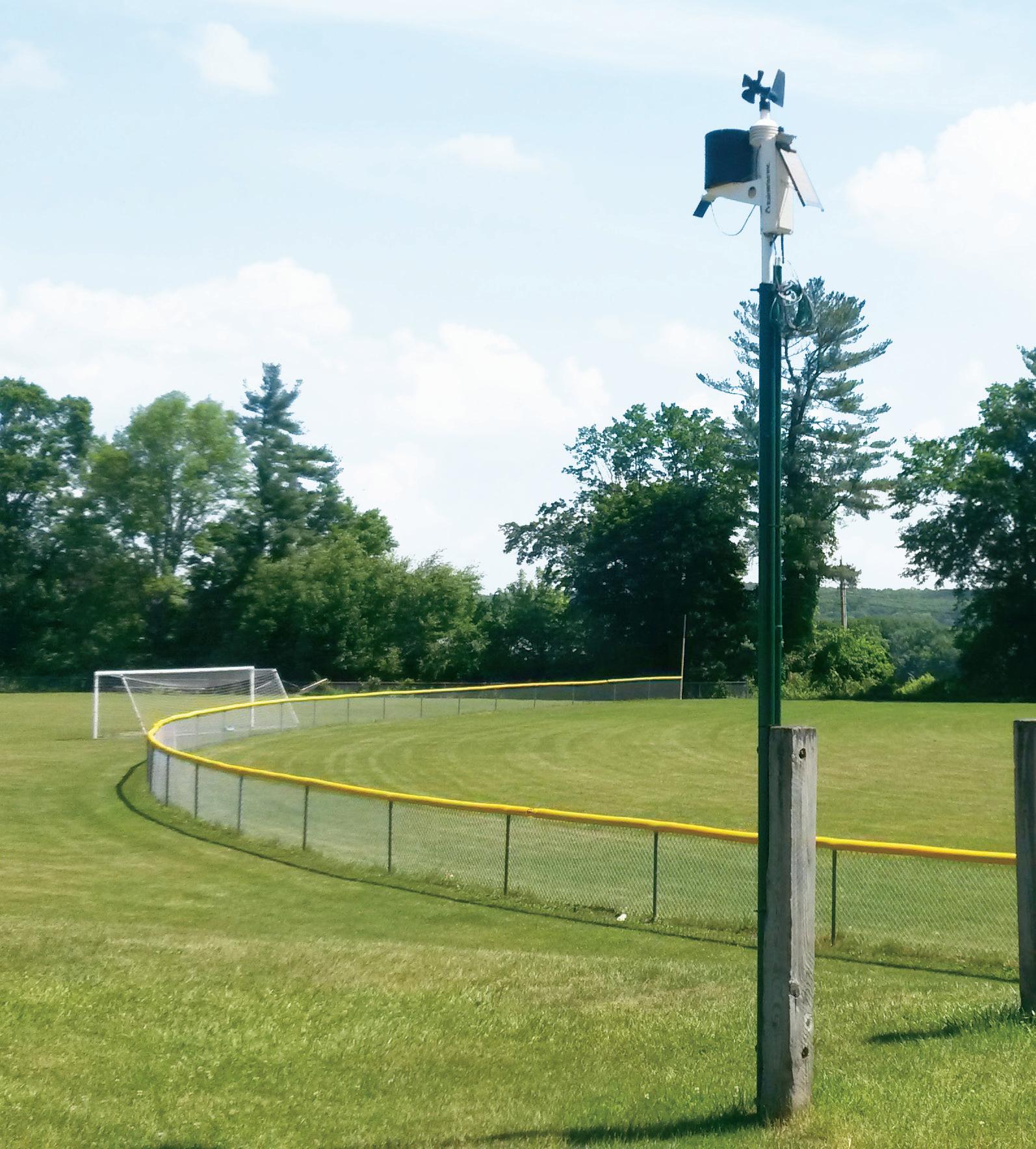
4 minute read
Using Weather Station Data on Athletic Fields
By Vickie Wallace and Alyssa Siegel-Miles, UConn Extension

Advertisement
Weather stations are a powerful tool that have long been utilized in production agriculture and have become essential equipment on golf courses and sports facilities. The ability to correct problematic management practices as early as possible, and to scout to prevent pest problems before they occur, helps athletic field and grounds managers better manage their fields and facility properties.
What are weather stations?
A weather station is a group of centrally organized instruments that measure atmospheric and soil conditions using many different sensors. On-site weather stations monitor the microclimate of a specific growing area, such as precipitation, air and soil temperature, evapotranspiration (ET), wind speed, and relative humidity.
Weather stations must be properly sited, installed, and maintained to be effective and reliable. To correctly site the weather station, it must be:
• In an open location, on level terrain, where no shading or disruption in wind flow can occur. It should be sited well away from all buildings, large structures, and trees, to account for seasonal changes in shade and wind patterns.
• Placed directly on a turf or landscaped area, in a location free from excessive radiant heat provided by adjacent driveways, sidewalks, and buildings, which act as heat “sinks” and produce misleadingly higher air temperatures, lower humidity, and higher ET values.
• Operational in a school/public environment location where protection from vandalism and firewall settings do not disrupt data transmission.
• Placed with a clear sight line to the location where data will be received.
Why is monitoring weather important?
Weather conditions can vary over short distances, so off-site measurements from a public weather network may not accurately reflect the precipitation and temperature in the immediate vicinity of a school’s athletic fields and grounds. For irrigation and Integrated Pest Management (IPM) decisions, more specific measurements may be required. Weather stations can be an integral tool for making:
1. Irrigation decisions:
• Athletic fields may require irrigation for turfgrass to remain dense and healthy, given the challenging conditions (e.g., compaction and heavy wear) associated with school athletic fields.
• Weather stations can estimate the evapotranspiration (ET) rate of a turfgrass area. Awareness of water loss through ET is a valuable component for making irrigation management decisions.
• Scheduling irrigation events according to observed ET water loss rates, rather than irrigating on an automatic schedule, minimizes ineffective watering and wasteful water loss.
2. Pest management decisions, as part of a comprehensive school IPM program:
• IPM is a sustainable and scientific approach to pest control that strives to address and correct the root causes of pest problems.
• Weather stations can support accurate IPM decisions. Pest management decisions based on growing degree days are more accurate than a calendar-based approach. The timing of insect development, disease activity, weed germination, and seedhead emergence of broadleaf and grassy weeds may vary based on seasonal weather conditions.
• Predicting the optimal time for chemical treatment, where chemical control methods are not prohibited, is dependent on accurate microclimate information.
How can the information collected from weather stations be used in turf management programs?
1. Irrigation scheduling:
• Help determine when and where to irrigate, based on soil moisture and ET readings.
2. Pest Management of Weeds, Insects, and Diseases:
• Improve decisions about timing of cultural management strategies and methods of potential control options.
• Estimate the timing of weed emergence, disease onset, and insect growth stages, based on Growing Degree Day (GDD) calculations and soil temperature readings.
Weed Management:
• Substantiate where/when to use pre- or post-emergent herbicide, where permitted.
• Many weed management decisions are based on the timing of seedling emergence, which can be especially challenging to predict, as weed seedlings emerge over an extended period of time. The timing of seedling emergence is influenced by many factors, including soil temperature, soil water availability, soil depth, and soil type.
Insect Management:
Weather station data can predict the best time to scout for damaging insect pests, as GDD may follow emergence or the morphological development of the pest.
• Insects’ growth and activity depends on the surrounding external temperatures. Their development is directly proportional to increasing heat as the season progresses.
• Turf managers can use information on the amount of accumulated heat units, measured in GDD, to create predictions of when to expect and scout for these insect pests.
• Where permitted, biocontrol agents or insecticides must be applied at the optimal time to ensure that treatment is as effective as possible.
Disease Management:
• Fungi that cause turfgrass diseases are dependent on certain environmental conditions for growth and infection. Monitoring temperature and moisture through weather stations makes it possible to predict and prepare for potential disease development. Disease forecasting can optimize the timing of treatment applications, if warranted and where permitted, and improve control.
3. Where pesticides are not allowed, weather stations can be:
A critically helpful tool for scouting (e.g., awareness of grub and beetle emergence) and timing of cultural practices (e.g., mowing to prevent weed seed development).
Vickie Wallace is an Extension Educator with UConn Extension. Contact her at ictoria.wallace@uconn.edu or (860) 885-2826.






